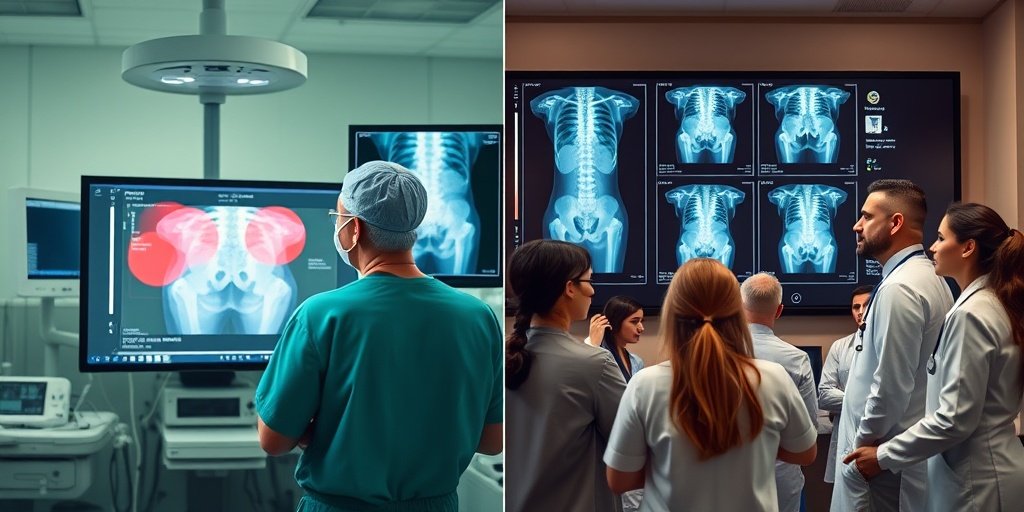⚡ Quick Summary
A recent study evaluated the impact of artificial intelligence (AI) on the interpretation of traumatic pelvic radiographs (PXRs), revealing that AI assistance significantly improved diagnostic accuracy from 0.870 to 0.940 and reduced interpretation time from 22.70 to 9.58 seconds. These findings highlight the potential of AI to enhance clinical workflows in trauma care settings.
🔍 Key Details
- 📊 Participants: 26 physicians (8 radiologists, 10 emergency physicians, 8 trauma surgeons)
- 🧩 Cases analyzed: 150 traumatic pelvic radiographs
- ⚙️ Study design: Multi-reader multi-case (MRMC) study with three evaluation sessions
- 🏆 AI support levels: No AI, AI-alert, and AI-visual guidance
🔑 Key Takeaways
- 📈 Diagnostic accuracy improved significantly with AI assistance (from 0.870 to 0.940).
- ⏱️ Interpretation time was reduced from 22.70 seconds to 9.58 seconds.
- 💡 Emergency physicians showed a 26.2% increase in specificity and a 41.5% increase in positive predictive value with AI support.
- ⚖️ Trauma surgeons using AI-visual guidance achieved comparable accuracy to radiologists (0.940 vs. 0.920).
- 🌉 AI assistance effectively bridges the performance gap between radiologists and non-radiologists.
- 🔄 Potential for AI integration to enhance clinical workflow efficiency across trauma care specialties.

📚 Background
The interpretation of pelvic radiographs is a critical component in the initial assessment of trauma patients. Despite their importance, challenges in accurately interpreting these images persist, particularly among non-radiologists. The integration of artificial intelligence into clinical practice has emerged as a promising solution to enhance diagnostic accuracy and efficiency, yet its practical implications across various specialties remain largely unexplored.
🗒️ Study
This study was conducted using a retrospective image-based approach, involving a total of 26 physicians who interpreted 150 PXRs across three sessions. The evaluation protocol was standardized and prospectively planned, allowing for a comprehensive analysis of the impact of AI on diagnostic performance. The physicians interpreted the images first without AI assistance, then with AI-alert, and finally with AI-visual guidance.
📈 Results
The results demonstrated that AI assistance significantly enhanced overall diagnostic accuracy, increasing it from 0.870 to 0.940 (p < 0.001). Additionally, the time taken to interpret the radiographs was notably reduced from 22.70 seconds to 9.58 seconds (p < 0.001). Emergency physicians exhibited substantial improvements in specificity and positive predictive value, while trauma surgeons utilizing AI-visual guidance achieved accuracy levels comparable to those of radiologists.
🌍 Impact and Implications
The findings of this study suggest that the integration of AI into the interpretation of traumatic pelvic radiographs could significantly enhance clinical workflow efficiency. By improving diagnostic accuracy and reducing interpretation time, AI has the potential to transform trauma care settings, allowing healthcare professionals to make quicker and more accurate decisions. This could ultimately lead to better patient outcomes and more effective use of resources in emergency medicine.
🔮 Conclusion
This study highlights the transformative potential of AI in the clinical interpretation of traumatic pelvic radiographs. By bridging the performance gap between radiologists and non-radiologists, AI can enhance diagnostic accuracy and efficiency in trauma care. As we continue to explore the integration of AI technologies in healthcare, further research is essential to fully realize their benefits and optimize patient care.
💬 Your comments
What are your thoughts on the integration of AI in clinical radiography? We would love to hear your insights! 💬 Leave your comments below or connect with us on social media:
Comparative analysis of AI support levels in clinical interpretation of traumatic pelvic radiographs.
Abstract
Plain pelvic radiographs (PXR) remain crucial for initial trauma assessment, yet interpretation challenges persist. While artificial intelligence (AI) shows promise, its practical impact across specialties remains unexplored. We conducted a retrospective image-based, multi-reader multi-case (MRMC) study using a standardized, prospectively planned evaluation protocol. A total of 26 physicians (8 radiologists, 10 emergency physicians, 8 trauma surgeons) interpreted 150 PXRs in three sequential sessions: without AI, with AI-alert, and with AI-visual guidance. AI assistance improved overall diagnostic accuracy from 0.870 to 0.940 (p < 0.001) and reduced interpretation time from 22.70 to 9.58 s (p < 0.001). Non-radiologists showed substantial improvements, with emergency physicians demonstrating increases in specificity (26.2%, p = 0.006) and positive predictive value (41.5%, p = 0.006). Trauma surgeons with AI-visual guidance achieved comparable accuracy to unaided radiologists (0.940 vs. 0.920, p = 0.556). Tailored AI assistance effectively bridges the performance gap between radiologists and non-radiologists while reducing reading time. These findings suggest AI integration could enhance clinical workflow efficiency across specialties in trauma care settings.
Author: [‘Tee YS’, ‘Huang JF’, ‘Huang YT’, ‘Hsu CP’, ‘Chen HW’, ‘Hsieh CH’, ‘Fu CY’, ‘Cheng CT’, ‘Liao CH’]
Journal: NPJ Digit Med
Citation: Tee YS, et al. Comparative analysis of AI support levels in clinical interpretation of traumatic pelvic radiographs. Comparative analysis of AI support levels in clinical interpretation of traumatic pelvic radiographs. 2025; 8:518. doi: 10.1038/s41746-025-01923-5